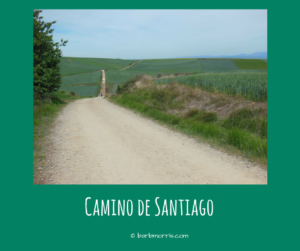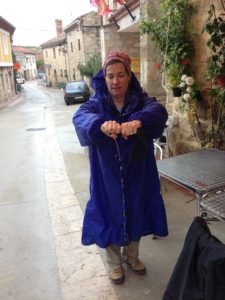 THIS IS A SCENE FROM MY CAMINO NOVEL-IN-PROCESS. PLEASE SEE THE FIRST EXCERPT, “THE MESSIES,” WHICH INTRODUCES THE NOVEL AND WHY I’M POSTING THIS WRITING IN ITS RAW STATE.
THIS IS A SCENE FROM MY CAMINO NOVEL-IN-PROCESS. PLEASE SEE THE FIRST EXCERPT, “THE MESSIES,” WHICH INTRODUCES THE NOVEL AND WHY I’M POSTING THIS WRITING IN ITS RAW STATE.
It’s a cold rainy day on the Way. A perfect day for pondering discomfort. Rain on the Camino means you walk in the rain. Unless you stayed the night in a hotel and you can book another night, you have to leave. You could go find a bar and sit there until the albergues open at 2:00, but, really, what’s the point of that? You might as well walk. The rain in Spain stays mainly in the plain – decidedly NOT true. Galicia is famous for being rainy, and it’s NOT in the plain.
One of the best pieces of advice Martha gleaned from the American Pilgrims on the Camino Facebook group was to buy an Altus poncho in St. Jean*. She’s grateful for it today. It’s big enough to cover her backpack – it comes with a pouch that snaps in and out – and it covers her legs, mostly, too.
The downside of not using a backpack cover is that if she needs something in her pack she has to get under the poncho somehow. The upside of the Altus covering her pack is that her pack stays dry, unlike the packs of the people she sees around her that are covered only with the backpack cover. The rain, especially this windy rain, will find its way in and around the cover. She’d rather have a wet body and a dry backpack.
Fortunately, along most of the Camino, there are frequent bars for getting warm, or at least warmer. This morning they’re packed full of wet walkers. Martha wedges her way through the pilgrims congregating in the main room jostling for the barkeep’s attention, and finds a place for her backpack, poles, and poncho where it can drip a little and hopefully not on someone else’s stuff. It’s dark in this bar – nooks and crannies all packed with pilgrims seeking refuge from the deluge outside. It’s an incessant rain. A thoroughly wet rain. NOT liquid sunshine. Feeling inside her layers for her passport and money, she pulls out a few Euro and joins the throng of peregrinos waiting for coffee. She’s pretty sure some of them are feeling impatient. They want this process to be efficient and orderly, but this is Spain. The land of six-hour workdays and afternoon siestas. Spaniards don’t rush, and they don’t like loud, pushy Americans and driven Germans.
She waits, drifting along with the tide of people toward her turn to order. “Café con leche, por favor, señor,” she says. “Y tiene tortilla? No? Pan tostada? Bien, gracias.” Toast it is. She ponders, again, the wonder that is Spanish toast. This is breakfast. Perhaps she’ll find tortilla further along the Way – or perhaps this will have to do until lunch. She’s already hoping for soup to go with her bocadillo*. Bread, bread, bread. All this lovely bread. It would be hard to be gluten-free on the Camino. It’d be easier to be vegetarian, by far. She sees out the door on her way back to a table in the corner, squeezing between dripping peregrinos, carrying her coffee and toast, that it’s still raining.
Everything on the Camino is a metaphor. How you do anything is how you do everything. She’s thinking about her students. Her FORMER students – how some of them were so open to screwing up, and some were so resistant. It’s about how well you tolerate discomfort, she knows. She knows this about herself, too. Her first instinct when she’s uncomfortable is to run home to mama. Go back to where she felt safe and warm and dry and unthreatened. It’s taken a long time to train her brain to overcome its first impulse. Part of that training comes from working with kids for as long as she has – she pretty early on noticed the disconnect between her wanting to be good at something right out of the gate, and encouraging her kids to explore and be messy in pursuit of a goal.
There they are again! Messies are part of learning. She knows this. Being okay with messies – seeing messes as compost rather than mistakes – has been huge in her life. Part of her goal, Martha realizes, on this camino craziness, is to get really good at messes. To take her best shot, to leave before she’s ready, to follow her gut and listen to her heart. To see the messes as holy – sacred – inevitable byproducts of growth. Necessary for growth.
Maybe messy isn’t even the right word, she thinks. Maybe it’s like the furrows left by the moles – or pencil shavings – or a snake’s skin, or dead leaves and shed branches or a beetle’s carapace after metamorphosis (do beetles shed their shells?) – like the chrysalis a butterfly leaves behind. Every process requires a mess if it’s deep enough, maybe?
Is my former life a chrysalis hanging on last year’s yarrow? I kept thinking the chrysalis was my forever home. Every metamorphosis, every turn of the wheel, every ride around the change cycle, leaves pieces behind. Every death and resurrection leaves a trail – a bundle of clothes inside a tomb. A memory.
I am so fucking wise, she thinks. When did I get so smart?! But it’s true. We all have these cycles. Cycles within cycles within cycles. And even though the Camino is a line from pt A to pt B, it has cycles within it. There’s the big beginning à middle à end à beginning again one from SJPP* or wherever, walking for 30 or 40 days, ending in Santiago, then going home. Within the big one, which is ALSO embedded in the larger cycle of my life, there are smaller cycles. There’s the cycle of each day, and the meeting walking parting cycle of ephemeral relationships, the cycle of each mile, the cycle of each step, even the cycle of each breath. There might be an accumulation and letting go cycle, too. Breathing is like that. Eating is like that. We breathe in O2 and exhale CO2. We eat food and let go of pee and poop.
So maybe messes aren’t negative at all – maybe they’re inevitable byproducts of changing ang growing. They’re our shed skins and chrysali (Gk?) and fallen leaves and husks of seeds. We are designed to grow and change. Learning is our job. And the only way to learn something new is to do something new. And the only way to do something new is to do it. And the only way to do something new is to embrace the feelings that go with not knowing how to do something and doing it anyway. Some of us are better at than than others, but ALL of us can learn it. (Or relearn it.) We all used to know it, when we were babies and we didn’t know about mistakes. Then school got ahold of us, and parents who needed us to be certain ways – to be competent so they felt competent, maybe, and we learned that learning was supposed to be seamless or we weren’t doing it right. And if we couldn’t do it right, we probably shouldn’t be doing it at all. If we couldn’t get it right pretty quick, then it wasn’t what we should be doing and we needed to go find the thing we COULD get right really fast, because that was our calling. And then we needed to keep doing that one thing over and over for the rest of our lives.
Does anyone do the Camino perfectly? Martha wondered. What would that even look like? Let’s see. You buy all the right gear the first time. You always walk as far as you intend to walk, and you always find a bed in your preferred albergue. Or, if you don’t, some lovely local gives you her spare room and you become friends for life. You never pee behind a bush or take a shit in the trees. No blisters and no injuries. You always have exactly what you need, and are able to give to less-prepared peregrinos from your excess.
Ewww. That sounds awful! That sounds dry and sterile and dead.
How about THIS for perfection: you do enough research and then you go and you survive. A lot of stuff goes wrong or doesn’t go the way you hope it will. There are times you’re uncomfortable – tired, cold, hungry, unsure, sore, scared – and yet here you are. You get through it, increasing your tolerance for feeling tired, cold, hungry, unsure, sore, and afraid. You roll with it. You surf the waves, rather than having a reeally good expensive boat. You’re IN it, rather than on it. And there are moments, even hours and days, of bliss and joy and exultation and warm happiness and simple true connection – of feet on the ground, breathing and walking and listening and seeing and smelling and tasting – feeling how strong your body is and how big your heart is and how delicioso it feels to be wild.
The rain continues to fall steadily as Martha leaves the damp warm dark bar. She peers out from beneath the already-dripping hood of her Altus poncho and finds the arrow* embedded in the rain-slicked cobbled street. She follows the arrow, hoping to get another ten kilometers under her belt before stopping for the night.
*CAMINO PLACES, NAMES, AND THINGS WHICH WILL NEED TO BE DEFINED, OR PERHAPS I’LL INCLUDE A CAMINO LEXICON.

